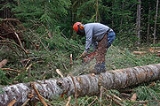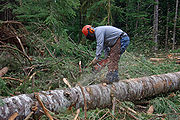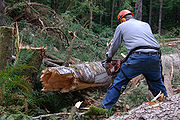
Log bucking
Encyclopedia


Felling
Felling is the name given to an area of land in eastern Gateshead, England. Originally an independent settlement in the historic county of Durham it became incorporated into the Metropolitan Borough of Gateshead in 1974....
and delimbed
Delimbing
*An extension or projecting part of a tree.When the tree is lying on the ground, branches may be storing enormous potential energy through mechanical strain. When a branch is cut, often with a chain saw, this energy can be released suddenly and the branch can jump dangerously. In addition, a branch...
tree into logs. This can be a complicated process because logs destined for plywood
Plywood
Plywood is a type of manufactured timber made from thin sheets of wood veneer. It is one of the most widely used wood products. It is flexible, inexpensive, workable, re-usable, and can usually be locally manufactured...
, lumber
Lumber
Lumber or timber is wood in any of its stages from felling through readiness for use as structural material for construction, or wood pulp for paper production....
, and pulp
Wood pulp
Pulp is a lignocellulosic fibrous material prepared by chemically or mechanically separating cellulose fibres from wood, fibre crops or waste paper. Wood pulp is the most common raw material in papermaking.-History:...
, each have their own price and specifications for length, diameter, and defects.
Methods
Bucking may be done in a variety of ways depending on the logging operation. Trees that have been previously felled and moved to a landing with a log skidderSkidder
A skidder is any type of heavy vehicle used in a logging operation for pulling cut trees out of a forest in a process called "skidding", in which the logs are transported from the cutting site to a landing. Here they are loaded onto trucks , and sent to the mill...
are spread out for processing. While many of the limbs have broken off during transport, the remaining limbs and stubs have to be trimmed. The bucker will anchor the end of an auto rewinding tape measure which is attached to his belt and walk down the log trimming as he goes. The tape is anchored gently with a bent horseshoe nail in the bark so it can be jerked loose when the measurement is completed. When a suitable place to buck the tree is located the cut is made. Local market conditions will determine the particular lengths cut. It is common for log buyers to issue purchase orders for the length, diameter, grade, and species that they prefer and will accept. There are often different prices for different items. The bucker is the one who turns a tree into logs, and to do his job properly must cut the tree for optimum value.
The person bucking is generally called a Bucksawyer or Bucklogger, or just a Bucker and runs as many saws as he can, switching out saws as soon as one is dull. The reason for this is the bucksawyer is typically paid per section of log he cuts. Generally you will find a bucklogger at the smaller sawmills that aren't fully mechanized. This method of logging is perhaps more dangerous than the actual felling of the trees for the bucklogger is usually cutting from the edge of a treepile which can be twenty feet high and as long as there is room to dump them from the truck. Each tree has to be picked out of the pile and cut so that a controlled fall of more trees can be worked as the former fall has been cut and skidded to its respective pile.
See also
- Forest productForest productA forest product is any material derived from a forest for commercial use, such as lumber, paper, or forage for livestock. Wood, by far the dominant commercial forest product, is used for many industrial purposes, such as the finished structural materials used for the construction of buildings, or...
s - UnderbuckingUnderbuckingUnderbucking is a type of log bucking. Underbucking is cutting upwards from the bottom of a suspended log.An underbucking tool can be made using an ax driven into the side of the log so that a crosscut saw can be turned upside down....
- AxeAxeThe axe, or ax, is an implement that has been used for millennia to shape, split and cut wood; to harvest timber; as a weapon; and as a ceremonial or heraldic symbol...
- Chain saw
- FellingFellingFelling is the name given to an area of land in eastern Gateshead, England. Originally an independent settlement in the historic county of Durham it became incorporated into the Metropolitan Borough of Gateshead in 1974....
- HewingHewingHewing is the process of converting sections of a tree stem from its rounded natural form into a form with more or less flat surfaces using primarily, among other tools, an axe or axes...
- Limbing
- LoggingLoggingLogging is the cutting, skidding, on-site processing, and loading of trees or logs onto trucks.In forestry, the term logging is sometimes used in a narrow sense concerning the logistics of moving wood from the stump to somewhere outside the forest, usually a sawmill or a lumber yard...

